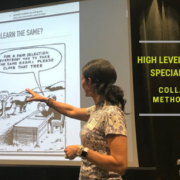How-to Check for Comprehension: High School
Comprehension: though this term has a simple definition, it is far from a simple concept. Comprehension centers on one’s ability to understand or make sense of something. It is truly a complex cognitive ability that can be difficult to measure and varies person to person.
Once adolescents arrive at the high-school level of their education, comprehension is an expectation in the classroom. Having progressed through years of schooling, high schoolers have had their comprehension assessed countless times. The methods for which to assess them over the years is just as varied. Whether via formal or informal assessments, comprehension at the high school level leaves no room for gray areas—students either comprehend a concept, or they do not. This is different from the lower grades, when students are still developing comprehension skills. So how can high schoolers check for and improve comprehension skills? The three-step strategy below is a proven process which expands a student’s comprehension skills.
- Annotate texts, assignment sheets, rubrics, etc. Essentially, any text can be annotated to check for understanding. When students receive an article, report, novel, etc., they should immediately assume the role of an active reader and writer. This means that, when reading, students should have a pencil and/or highlighter in hand, ready to record as they read. This is not an innate skill; it takes practice and consideration. Highlighting is not merely enough—students have to indicate why they have highlighted something, which is where margin notes come into play. This process helps to ensure that students are actively engaged in the text, following along and thinking critically as they read.
- Employ close reading, of which annotating is an important aspect. Close reading involves a critical analysis of a text that requires the reader to engage closely with the text by focusing on significant details, patterns, and other distinguishable aspects of the author’s writing. Close reading asks that readers question or critique the artistic choices of the author, i.e., Why did he include that simile? What is the meaning of that term as it is used in the context of the paragraph? What is the greater message that the author may have been trying to convey? Close reading encourages readers to look at the text in layers, similar to that of an onion. As we peel back the layers, we ask different questions of the text. First, what is the author saying? Then, how is the author saying it? And finally, why would the author choose to say it in such a way?
- Respond to the text. Having annotated and performed a close reading of the text, a final method for ensuring comprehension is to respond to the text. With the notes that the student has taken, and the observations and critiques that have been made, high schoolers can exhibit further comprehension by responding in various forms, but likely a written response. High school students can create book reviews, author reviews, argumentative or persuasive pieces, etc. By commenting on a text in a critical way, students are able to show that they have not only comprehended the material, but also analyzed it critically.








